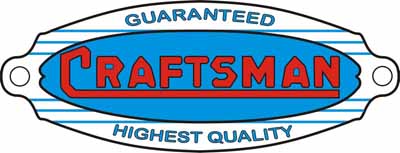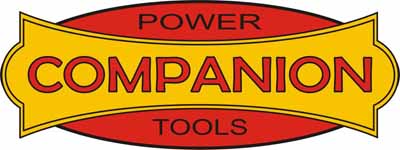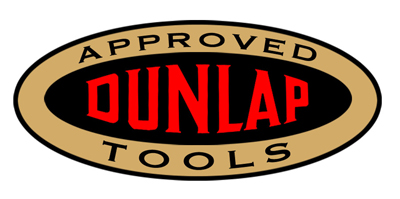Overview of Sears Roebuck's "Craftsman" Brand

Craftsman label from our archive of machinery decals
Craftsman is the premier brand name for Sears, Roebuck & Co. and Simpsons-Sears / Sears Canada. The Craftsman trademark was registered by Sears on May 20, 1927. A variety of companies manufactured tools for Sears under the Craftsman name. If you want to identify the manufacturer of a Craftsman wood-working or metal-working machine, engine, motor, vise or handheld power tool that was made in North America , follow the link under "Sears, Roebuck Number Prefixes", below. This website does not provide information on other products that Sears sold, nor does it cover products made outside North America, UK or Sweden.
"Craftsman" is only one of several brand names used by Sears, Roebuck on products of interest to this website.
- ACME was used on post drills in the early 1900s.
- COMMANDER was used on some Sunlight-built electric motors and grinders in the 1930s.
- COMPANION was an early brand name (from 1933 or thereabouts) for Sears Roebuck tools. Companion tools were less expensive than the contemporaneous Craftsman tools. It was replaced by the Dunlap name in 1941, at least on machinery; the Companion name was still used on some handheld tools. In 1998 Sears applied for a trademark on the Companion name, for use in on a vast list of products, and the Companion name started appearing on low-end Asian-made woodworking machines. This website does not cover Asian-made machines and we have no other information on them.
- DUNLAP was a Sears brand used on their basic-feature machines. Some older Dunlap machines were still good quality, and remain very good values. Dunlap-branded machines were made by Atlas Press, Central Specialty/King-Seeley, and others.
- EVER READY was used on pump motors built by Packard Electric.
- FULTON was used by the Sears hardware department on some basic-feature tools and electric motors.
- KENMORE is best known for household appliances, but the name was also used on some electric grinders and motors in the 1930s.
- METALCRAFT was used on some lathes made by Atlas Press and sold by Sears.
- POWER CHIEF was a name used on some early 1930s motors.
- SAMSON was another predecessor to Dunlap, used on less expensive tools, and, especially, vises.

Companion label from our archive of machinery decals

Dunlap label from our archive of machinery decals
Some machines sold by Sears Roebuck (including all machines before about 1930) did not use any of the Craftsman, Companion, or Dunlap names, but were branded simply as "Sears, Roebuck & Co." An example is a scrollsaw made by Syncro.
Makers of Wood-working Machines, Metal-working Machines, and Stationary Engines for Sears
The list below contains the known makers of the above-mentioned products only. For a more complete list of makers of Sears products, see the section "Sears, Roebuck Number Prefixes", below.
Sears Roebuck introduced wood-working machinery in their 1926 catalog, according to one source. Here is a list of known North American-based makers of their machinery with their model-number prefixes (some companies do not have a model-number prefix because they manufactured for Sears before they introduced the prefix system):
The last generations of machinery sold by Sears were made in Asia and hence are outside the scope of this web site. Of course, Sears sold an enormous variety of products that are outside the scope of this site. We solely cover woodworking and metalworking machinery, engines and motors, vises and handheld power tools, and of those we only cover products made in USA, Canada, Sweden and the UK.
Brief History
Craftsman is the main brand name used by Sears, Roebuck & Co. for their wood-working and metal-working machinery and other products. Sears also used the Companion, Dunlap, and Fulton names. In Canada, the Craftsman name was also used by Simpsons-Sears Ltd. and then Sears Canada, Inc.
Sears, Roebuck and Co.: early history
In 1886 in North Redwood, MN, a jewelry store received a shipment of watches they didn't want. The store sold them to Richard W. Sears, a local telegraph operator, who sold them to railway workers for a profit. Sears realized that there was a good market for this service, and started the R. W. Sears Watch Co. He relocated to Chicago in 1887, and found a partner, watch repairman Alvah C. Roebuck. In 1893 the company was renamed to Sears, Roebuck & Co. Sears, Roebuck expanded rapidly in the 1890s because of their catalog sales, especially to farmers. In 1925 they opened their first retail store. By 1933 they had 400 stores.
The story of the Craftsman name
From the Sears Retirees web site
"Historians do know the origin of the Craftsman brand name. In 1927, Sears hired Arthur Barrows to head the company's Hardware Department. Barrows knew hardware and wanted to create a brand name for Sears hardware that distinguished it from other manufacturers. Barrows liked the name Craftsman used by the Marion-Craftsman Tool Company and offered Marion-Craftsman a reported $500.00 for the rights to use the Craftsman name on Sears products.
"When Sears promoted Barrows to West Coast Manager, he hired Tom Dunlap to take over the hardware department. Dunlap immediately upgraded the quality of the tools. He threw out all the big, clumsy, cheap, cast-iron hammers and wrenches, and the soft screwdrivers that were hangovers from the days when farmers were the company's biggest customers. Dunlap recognized that America had moved into the automobile age and that Sears needed a line of high quality tools to meet this new demand.
"Tom Dunlap understood the pride a good mechanic had in their tools and how most mechanics meticulously cleaned their tools at the end of each day. He decided to improve the look of Craftsman tools by adding chrome plate to improve the finish, color, and trim on wrenches and sockets, and high impact plastic handles on screwdrivers. Dunlap's old boss, Arthur Barrows did not think it made sense to chrome plate a tool that someone would "slug the hell out of" when using, but Dunlap's persistence paid off and sales of chrome plated tools increased six times the next year. Craftsman full polish wrenches quickly became popular with mechanics because they were reliable, looked good, and were easy to clean."
Sources of Manuals and Parts
Parts and manuals are more readily available for Sears products than for most makes of woodworking machinery. Still, it may take some effort to track down what you are looking for, and if your machine is especially old (pre-WWII) or obscure then you may be unsuccessful. The list below contains suggestions on where to look.
- Look under the "Publication Reprints" tab, above, for a manual. Our collection is not complete, but if you cannot find the exact manual you are looking for, look closely for similar products, as some machines with different model numbers were virtually the same except for the accessories, motor or switch.
- Check out the "Publication Reprints" sections of the following related entries:
- Look under the entry corresponding to the manufacturer of your machine in the "Makers" section, above.
- More information is available in the Wiki, including information on Craftsman paint colors.
- You can find diagrams and parts list for some Craftsman machines from the Sears Web Site. Just put in your model number into the search box and search.
- Copies of manuals for many vintage Craftsman machines are still available. Call the Sears Parts Line, 1-800-469-4663, and have your model number ready.
- Emerson Electric (800-325-1184) is another contact for machines with source code 113 or 103.
Emerson has recalled 3.7 million of their Craftsman radial arm saws made between 1958 and 1995. For saws that cannot be upgraded they will give $50 for the return of the carriage. For others they have an upgrade package for the blade guard assembly and MDS saw table & support. This is completely free, including shipping.
Emerson's recall site: http://www.radialarmsawrecall.com/ Phone #: (800) 511-2628.
Sears, Roebuck Number Prefixes
Beginning in the mid 1930s, Sears model numbers had a three-digit numeric prefix that identifies the true manufacturer. The following pages list Sears model number prefixes and the corresponding manufacturer who made the item for Sears.
Sears model numbers with prefix "9-" were used on hand tools and accessories. This prefix does not identify a manufacturer. “9-“ also known as “09-“ refers to the hardware department.
Information Sources
- Address (1949-1950 Popular Mechanics): Sears Roebuck & Co, State and Van Buren Streets, Chicago, Illinois.
- The addition of DeWalt to the list of makers was spurred by a posting by Jeff McVey to the owwm discussion forum.
- The existence of the Fulton name is from the book, Catalogues and Counters: A History of Sears, Roebuck & Co. by Boris Emmet and John E. Jeuck, and was forwarded to us by Ashley Kennedy.
- The information on Syncro was added as the result of an entry to the Photo Index by Dewayne Garrett.
- The makers behind model-number prefixes 115 and 397 were identified through detective work by members of the OWWM community. Earlier Sears manufacturer lists incorrectly identified these makers. Brian Kachadurian was the one who nailed down both makers, based on a comparison of Sears-badged motors and grinders compared to products known to have been manufactured by Sunlight and Delco. In the case of Sunlight, OWWM contributor Jeff Wilson provided a key piece of evidence in the form of a patent number on a Companion bench grinder that is identical to a later model with model-number prefix 115.
- The maker behind model-number prefix 551, found on some Craftsman electric motors, was deduced by comparing those motors to motors from known manufacturers, and finding a match with those from Leland Electric Co. SKF confirmed that an odd-sized SKF bearing used in one of those 551 motors was made exclusively for Leland. Thanks to Brian Kachadurian for making this connection.
- The maker behind model-number prefix 429, found on early Craftsman swing saws and 3-wheel 12" bandsaws, was discovered via an illustrated advertisement in the April 1950 Popular Mechanics for Lewis Machine Tool Co.'s swing saw.
- More history and machine information about Craftsman, Dunlap, Companion & Lathes by the "AA" Company can be found at Tony Griffith's Lathes.UK Website.